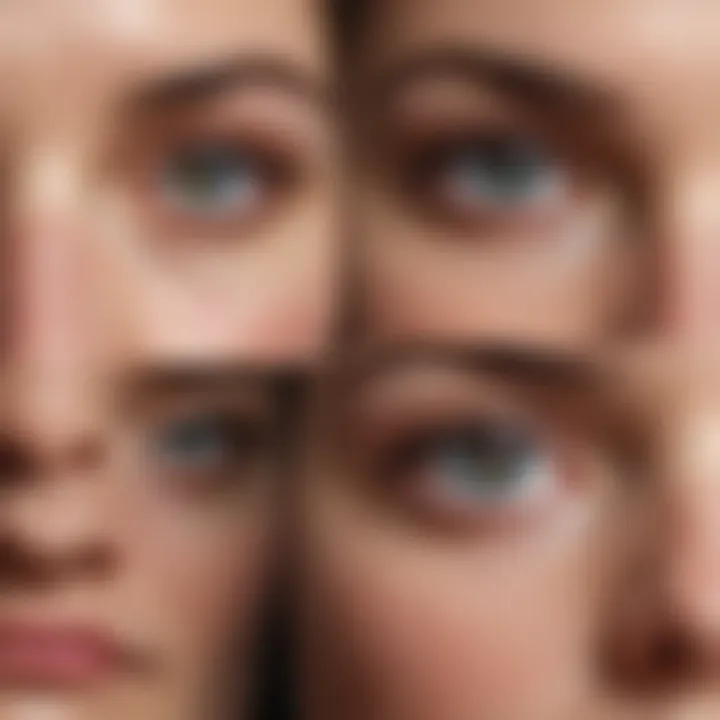Finding the Best Eye Cream for Puffiness


Intro
Puffiness around the eyes is a common concern that affects many individuals, regardless of age or skin type. Factors such as lack of sleep, stress, and genetics can contribute to this issue. As a result, the search for effective eye creams becomes important in skincare routines. This article aims to explore various attributes of eye creams that target puffiness, including essential ingredients and consumer feedback.
The goal is to empower women with knowledge that allows for informed decisions when selecting an eye cream. Each woman's experience with puffiness may vary, which is why understanding personal skin types is crucial. Below, we will explore the following key sections: essential beauty tips, in-depth product reviews, and an analysis of how seasonal and social influences shape our choices in skincare.
Understanding Eye Puffiness
Understanding eye puffiness is a critical aspect of skincare that often gets overlooked. Puffiness around the eyes can significantly impact one's appearance, leading to a tired and aged look. This section delves into the significance of recognizing the causes and distinguishing factors of puffiness. It sets the foundation for finding effective solutions, particularly eye creams, to address this common issue. By understanding the underlying reasons for puffiness, individuals can approach their skincare routine with informed choices.
Awareness is key. Many assume all eye concerns are the same. However, this is not accurate. Each specific condition requires tailored treatments. This understanding not only aids in selecting appropriate products but also enhances one's overall well-being. Moreover, identifying the nature of puffiness helps in creating a routine that integrates both preventive and corrective measures. Therefore, comprehending eye puffiness is essential not just for aesthetics but for achieving healthy skin that resonates with vitality.
What Causes Puffiness?
Puffiness around the eyes can result from various factors. One primary cause is fluid retention, which may stem from poor sleep, excessive salt intake, or hormonal changes. When the body retains water, it can manifest as swelling in the delicate area around the eyes.
Another possible reason is genetics. Some people inherit a predisposition for puffiness, making them more susceptible, regardless of their lifestyle choices. Aging is yet another critical factor. As skin loses elasticity over time, the fat pads in the eye area may sag, leading to a puffy appearance.
Allergies and skin conditions can also play a role. Allergic reactions may cause inflammation and swelling. Similarly, conditions like eczema can contribute to puffiness due to irritation. Lifestyle choices, like inadequate hydration, smoking, and excessive alcohol consumption, further aggravate the situation. Identifying the specific cause of puffiness is essential for effective treatment, and eye creams can be a significant part of this strategy.
Differentiating between Puffiness and Dark Circles
While both puffiness and dark circles are common concerns around the eyes, they are distinctly different in nature. Puffiness refers to swelling or inflammation, often making the area look puffy or bloated. Dark circles, on the other hand, typically appear as darker shades under the eyes, often accompanied by shadows.
Understanding the difference is vital for choosing the right remedy. For instance, if someone is experiencing puffiness caused by fluid retention, they may want to look for eye creams containing caffeine or peptides. These ingredients can help reduce swelling.
Conversely, if the issue involves dark circles linked to pigmentation or blood vessel visibility, solutions may involve products with vitamin C or retinol to brighten and even out skin tone.
In summary, recognizing whether the concern is puffiness or dark circles allows the individual to use targeted treatments. This not only aids in achieving desired results more effectively but also enhances the overall efficiency of one’s skincare routine.
The Role of Eye Creams
Eye creams play a vital role in addressing the delicate skincare needs around the eyes, particularly when it comes to puffiness. The skin in this area is thinner and more prone to issues, making specialized creams essential. These products are formulated to provide targeted treatments that ordinary moisturizers may not effectively deliver. The right eye cream can significantly enhance one's skincare routine, addressing puffiness while offering hydration and nourishment.
Why Use Eye Creams?
Using eye creams can provide multiple benefits that are unique to the skin's requirements in the eye area. The texture and composition of eye creams are designed to penetrate deeply without feeling heavy or greasy. This absorption is crucial because the skin around the eyes is sensitive and can react to heavier formulations. Here are some reasons to consider using an eye cream:
- Targeted Solutions: Eye creams can contain specific active ingredients that directly address puffiness, dark circles, and wrinkles.
- Gentle Formulation: Many eye creams are developed for sensitive skin, minimizing irritation.
- Hydration Boost: They often provide moisture that helps maintain elasticity and firmness around the eyes.
Active Ingredients in Eye Creams
The effectiveness of eye creams largely depends on their active ingredients. Certain compounds have proven beneficial in addressing puffiness and rejuvenating the eye area. Below are some key ingredients commonly found in eye creams.
Hyaluronic Acid
Hyaluronic Acid is known for its remarkable ability to retain moisture. It can hold up to 1000 times its weight in water, making it an excellent hydrating agent. In the context of eye creams, it provides a plumping effect, which can diminish the appearance of puffiness. One unique feature of Hyaluronic Acid is its humectant properties, allowing it to draw moisture from the environment. While it generally offers many advantages such as hydration and reducing fine lines, those with extremely oily skin may prefer lighter formulations.
Caffeine


Caffeine is often included in eye creams due to its ability to constrict blood vessels, effectively reducing swelling and puffiness. Caffeine also has antioxidant properties, which help protect the skin from damage caused by free radicals. A key characteristic of caffeine is its quick absorption, making it beneficial for a rapid refresh. However, it might not provide long-lasting effects compared to other hydrating ingredients, making proper use important.
Peptides
Peptides are short chains of amino acids that play a crucial role in collagen production. They help improve skin elasticity, making them a popular choice in eye creams targeting puffiness. Peptides can stimulate the skin's natural repair processes, which is an advantage for long-term use. The unique feature of peptides is their ability to promote skin renewal, but they may take some time to show noticeable results.
Retinol
Retinol, a derivative of vitamin A, is celebrated for its effectiveness in promoting skin renewal and improving texture. In eye creams, it helps combat fine lines and can reduce the appearance of puffiness over time by enhancing skin cell turnover. A key characteristic of Retinol is its potency; it requires careful application to avoid irritation, especially in the delicate eye area. Its benefits can be profound in combating the signs of aging, but users must be mindful of sensitivity and potential reactions.
Evaluating Ingredients
Evaluating the ingredients in eye creams specifically formulated for puffiness is crucial for making an informed choice. An informed user understands that not all ingredients are equal. Some may provide real benefits, while others can cause irritation or worsened conditions if they are applied to the delicate eye area. The right ingredients can alleviate puffiness, while the wrong ones can hinder results, leading to frustration and wasted resources.
When examining eye creams, it is essential to analyze active ingredients that target puffiness effectively. This scrutiny will help determine the cream's overall efficacy and suitability for your skin type. Ingredients should not only be chosen for their immediate effects but also for their long-term benefits. Understanding these ingredients will empower individuals to select products that fit their specific skin concerns and lifestyle needs, enhancing their skincare routines.
In addition, being mindful of ingredients that could irritate the skin is equally important. This ensures a pleasant experience without adverse reactions. Thus, evaluating ingredients is a foundational step to discovering the optimal eye cream for puffiness, making it an indispensable part of your skincare journey.
Choosing the Right Ingredients for Puffiness
Selecting the right ingredients is paramount when addressing puffiness around the eyes. Some key components commonly found in effective eye creams include:
- Hyaluronic Acid: This ingredient is highly effective in retaining moisture, leading to plumper, more hydrated skin. This can help reduce the appearance of puffiness as hydrated skin tends to look brighter and smoother.
- Caffeine: Found in various eye creams, caffeine is known for its ability to constrict blood vessels. This action can significantly reduce swelling and puffiness, making it a popular choice for those experiencing tired eyes.
- Peptides: These can promote collagen production. Enhanced collagen can lead to better skin elasticity, which may help the area appear tighter and less puffy over time.
- Retinol: Though often associated with anti-aging properties, retinol can also encourage skin renewal. This can help improve the overall texture and reduce the visibility of puffiness when used consistently over time.
Choosing eye creams with these active ingredients creates a tailored approach to treat puffiness effectively, allowing individuals to align their skincare choices with their unique needs.
Potential Irritants to Avoid
While some ingredients can be beneficial, others can cause irritation and discomfort, potentially worsening puffiness. It is vital to identify these irritants before incorporating a new eye cream into your routine. Here are a few ingredients to be cautious of:
- Fragrances: Often added for pleasant scent, fragrances can be irritating, especially for sensitive skin. Opt for fragrance-free formulations.
- Alcohols: Certain types of alcohol can dry out the skin, leading to increased puffiness rather than reducing it. Check that alcohol is not listed among the first few ingredients.
- Synthetic Dyes: These can cause reactions in some individuals, leading to redness or puffiness. Look for natural formulations that avoid artificial colorants.
Understanding these potential irritants allows you to make educated decisions about which products to use. Avoiding such elements helps ensure a positive experience and results with your eye creams.
Top Eye Creams for Puffiness
Selecting the right eye cream specifically to address puffiness is essential for achieving a refreshed appearance. Puffiness around the eyes can stem from various factors such as fluid retention, lack of sleep, and genetics. Eye creams can offer targeted solutions to these issues, making it crucial to understand their features and benefits. Here, we delve into product comparisons and insights from product reviews to help identify the most effective options.
Product Comparisons
Brand A
Brand A is known for its lightweight formula that absorbs quickly into the skin. A key characteristic of this eye cream is its use of caffeine as an active ingredient. Caffeine is renowned for its ability to temporarily constrict blood vessels, which can lead to decreased puffiness. This makes Brand A a popular choice among consumers looking for immediate results. One unique feature of this product is its cooling applicator, which adds an extra layer of soothing action during application. However, it is essential to note that while some may see quick results, others may find it not hydrating enough for long-term use.
Brand B
Another notable contender is Brand B, celebrated for its rich blend of peptides aimed at promoting firmness and elasticity. The cream's luxurious texture appeals to those who prefer a more hydrating option for nighttime use. The inclusion of peptides can support skin barrier health over time, making it an excellent choice for individuals focused on both immediate and long-lasting benefits. However, it may take longer for visible effects to appear, and its thicker consistency may not be appealing to those who want a lighter formula.
Brand
Brand C stands out with its innovative use of hyaluronic acid, known for its deep hydration properties. This ingredient can help retain moisture, which in turn may aid in reducing puffiness over time. Customers appreciate how this cream brightens and revitalizes the under-eye area while providing a refreshing texture. Nevertheless, potential users should consider that it might require consistent use for noticeable results, and those who prefer quick fixes may be left unsatisfied initially.


Exploring Product Reviews
When evaluating different eye creams, user reviews play a vital role in understanding the effectiveness of a specific product. Many users report positive experiences when consistently using these creams. They often comment on the noticeable reduction in puffiness, and some appreciate the added hydration benefits.
"Consistency is key. I started seeing results after a few weeks of daily use of Brand A. The puffiness around my eyes is much less noticeable now," shares one user.
However, some individuals also mention potential irritations, such as redness or stinging sensations, particularly with products that have active ingredients like retinol. It’s crucial to read these reviews and take note of any concerns, especially if you have sensitive skin.
To summarize, assessment of eye creams for puffiness goes beyond just ingredient analysis; personal experiences and detailed product reviews are key in your decision-making process. Understanding the benefits and drawbacks of brands like Brand A, Brand B, and Brand C will empower you to make informed choices tailored to your individual skin needs.
Application Techniques
Understanding the correct application techniques of eye creams is paramount for effectively combating puffiness. When it comes to the delicate skin around the eyes, method and approach truly matter. Proper application can enhance absorption, ensuring that the active ingredients penetrate deeply and offer the desired results. Moreover, incorrect application can lead to irritation or even exacerbate puffiness rather than alleviate it.
Key elements in application include the direction of movement, pressure used, and timing. Gentle patting is generally preferred, as it minimizes the risk of tugging or pulling the skin. This technique not only respects the sensitivity of the area but also promotes circulation, which can further reduce puffiness.
In addition, utilizing the right amount of product is essential. Both excessive and insufficient application can hamper results. Too much cream can lead to product buildup and potential milia, while too little may not provide adequate moisturizing benefits.
How to Apply Eye Cream Effectively
To maximize the benefits of your eye cream, follow these simple steps:
- Cleanse your face: Ensure your skin is clean and dry before applying any products. This helps eliminate impurities that could interfere with the absorption of ingredients.
- Use your ring finger: This finger has the lightest touch, making it ideal for the sensitive eye area. Using your ring finger minimizes the risk of applying too much pressure.
- Apply a small amount: A pea-sized amount is usually enough. Dab it gently onto the skin, using little dots along the orbital bone. This includes the area just below your eye, the outer corners, and the brow bone.
- Pat gently: Rather than rubbing, gently pat the cream into the skin. Move from the inner corner of the eye outwards and then up around the brow bone. This encourages lymphatic drainage and improves circulation.
- Don’t forget the eyelids: If the product allows, apply a small amount to your upper eyelid as well. However, keep it away from your lash line to avoid product getting into your eyes.
Keep in mind to avoid getting eye cream too close to the eyes to prevent irritation.
Frequency of Application
Consistency is vital when using eye creams, especially for puffiness. Most skincare routines recommend applying eye cream twice a day: once in the morning and once at night. The morning application preps the skin for the day ahead, helping to combat puffiness that can occur due to lack of sleep or environmental factors. Applying it in the evening allows the cream to work overnight, promoting rejuvenation while the body repairs itself.
Consider your personal skin type and any specific ingredients in your chosen product. Some creams with retinol or strong active ingredients may be best used once a day or every other day to prevent irritation.
"Regularity in application can significantly impact the overall effectiveness of the eye cream."
Ultimately, understanding the application techniques and frequency allows one to maximize the benefits of an eye cream designed to tackle puffiness. Adjusting these practices to suit individual needs will provide a more effective approach to achieving visibly brighter and less puffy eyes.
Complementary Skincare Practices
Managing eye puffiness effectively involves more than just topical treatments. Complementary skincare practices play a vital role in achieving the desired results. These practices encompass lifestyle adjustments and daily habits that can enhance the efficacy of eye creams and improve overall skin health.
The significance of these practices lies in their holistic approach. They target underlying causes of puffiness, which often stem from sleep deprivation, dietary choices, and hydration levels. When combined with the right eye cream, these adjustments can lead to noticeable improvements in appearance.
Lifestyle Changes to Reduce Puffiness
Making specific lifestyle changes can significantly reduce eye puffiness. Here are some key strategies:
- Adequate Sleep: Prioritize your sleep schedule. Aim for 7 to 9 hours of sleep per night. Quality rest is crucial for skin rejuvenation.
- Diet Improvements: Eat a well-balanced diet rich in fruits and vegetables. Foods high in antioxidants and vitamins can help combat inflammation. Reducing salt intake is important too, as sodium can lead to water retention.
- Reduced Alcohol: Limit alcohol consumption. Alcohol can dehydrate the body and cause skin to appear puffy.
- Regular Exercise: Engage in regular physical activity. Exercise boosts circulation and reduces stress, which may contribute to puffiness.
Implementing these lifestyle changes can create a significant impact on skin health and appearance, particularly around the eyes.
Importance of Hydration and Sleep


Hydration and sleep's roles in skincare, especially for reducing puffiness, cannot be overstated. Proper hydration is essential to maintain skin elasticity and moisture levels. Skin that is well-hydrated appears plumper and less prone to puffiness.
"Dehydration can lead to sagging skin, accentuating puffiness around the eyes."
In addition to hydration, quality sleep is necessary for skin recovery. It is during sleep when the body repairs itself and regenerates skin cells. Poor sleep can increase cortisol levels, leading to inflammation and puffiness. Here are some tips to enhance both hydration and sleep:
- Drink Plenty of Water: Aim for at least 8 glasses of water each day to keep your body hydrated.
- Herbal Teas: Include herbal teas, such as chamomile, that can help with relaxation and hydration.
- Sleep Hygiene: Establish a consistent bedtime routine. Create a calming environment to promote better sleep quality.
In summary, embracing these complementary skincare practices lays a strong foundation for effective puffiness reduction. By combining the right eye cream with lifestyle changes and hydration, one can achieve a more refreshing and vibrant appearance.
Consulting with Professionals
Consulting with professionals is a crucial step in the journey to manage eye puffiness effectively. Both dermatologists and aesthetic specialists possess the expertise to assess individual skin types and recommend personalized solutions. This guidance can be especially beneficial for those who have not seen satisfactory results from over-the-counter products.
When considering eye creams for puffiness, it is important to recognize that not all ingredients suit every skin type. Professionals can provide insights on the most effective ingredients for your unique needs, potentially saving time and money on ineffective products.
When to Seek Dermatological Advice
It is advisable to seek dermatological advice if you notice persistently swollen areas around your eyes that do not improve with lifestyle adjustments or commercial creams. Other signs warranting consultation include:
- Severe swelling or redness in the eye area
- Development of rashes or unusual skin reactions after using products
- Genetic influences contributing to puffiness
- If you have other skin-related concerns that might overlap with puffiness
Early consultation can lead to better outcomes. Professional evaluations may identify underlying issues that require tailored skincare regimes or medical treatments.
Understanding the Role of Aesthetic Treatments
Aesthetic treatments can offer additional options for managing eye puffiness, especially when traditional methods have proven insufficient. Therapies such as fillers or laser treatments are increasingly sought after in aesthetic clinics. These methods work by targeting specific issues under the skin that contribute to puffiness. They can provide immediate results that topical creams may not deliver. However, it’s essential to have realistic expectations and understand the possible risks and benefits.
Before considering such treatments, consulting with trained professionals will ensure safety and appropriateness. Discussing these options openly can help you make informed decisions based on medical advice rather than social media trends or advertisements.
Professional consultations enable women to navigate the myriad of choices in skincare effectively, leading to products and treatments that truly meet their needs.
Incorporating feedback from aesthetic professionals into your skincare strategy might be the difference between a temporary remedy and a long-lasting solution for puffiness.
Long-term Solutions for Puffiness
Addressing eye puffiness requires an understanding of both immediate remedies and long-term strategies. While eye creams can provide short-term relief, establishing long-term solutions is vital for sustained results. Long-term approaches not only aim to minimize puffiness but also target the underlying issues contributing to its formation. They allow for better skin health and resilience, ultimately resulting in a smoother, revitalized appearance around the eyes.
A consistent skincare routine can play a significant role in achieving long-lasting results. Additionally, monitoring changes in your skin and adjusting products accordingly can help in maintaining optimal effectiveness in your regimen. Engaging with these practices consistently fosters healthier skin overall. This section will unpack these long-term strategies in detail, providing insights that will help readers implement effective solutions for eye puffiness.
Establishing a Consistent Skincare Routine
Creating a consistent skincare routine is crucial for managing and reducing eye puffiness over time. This form of commitment allows the skin around the eyes to adapt and respond positively to the products being used. The routine should include the right combination of cleansing, moisturizing, and protection.
- Cleansing: Keeping the delicate eye area clean is fundamental. Use a gentle cleanser to remove impurities without causing dryness or irritation.
- Moisturizing: Apply eye creams that contain active ingredients known for their effectiveness against puffiness, such as hyaluronic acid, caffeine, and peptides. Replenishing moisture to the skin around the eyes helps to maintain elasticity and firmness.
- Sun Protection: Sunscreen plays a role in long-term care. UV exposure can deteriorate skin quality, causing puffiness among other issues. Use a broad-spectrum sunscreen daily to protect the delicate skin around the eyes.
- Night Care: Consider a more intensive eye treatment during the night. Night creams can provide deep hydration and support skin repair as you sleep.
Consistency is key; applying products at the same time each day helps in creating a habit, paving the way for noticeable improvements in your skin's texture and appearance.
Monitoring Changes and Adjusting Products
Keeping track of any changes in your skin is essential in your quest for a perfect eye cream. Each person's skin responds differently to products, and being observant allows for timely adjustments. Here’s how to effectively monitor and adjust your approach:
- Observe Changes: After establishing your routine, pay attention to how your skin responds over weeks. Look for signs such as reduced puffiness, irritation, or new issues that may arise.
- Record Findings: Maintaining a skincare journal can help track reactions and results over time. This makes it easier to identify what works and what doesn't.
- Experiment: Don't hesitate to try new formulations or brands, especially if you don't see desired results. Adjust your routine to incorporate products with varied ingredients that target puffiness more effectively.
- Consultation: Every now and then, seek advice from skincare professionals. They can provide personalized recommendations based on your specific needs and concerns.
"Long-term engagement with your skincare routine is as important as the products you choose. Monitoring and adjusting ensure effectiveness and skin health remain a priority."
By establishing a thorough routine and being attentive to changes, one can significantly mitigate eye puffiness over time. Developing these long-term solutions enhances your skincare journey, contributing to a more refreshed and youthful appearance.



